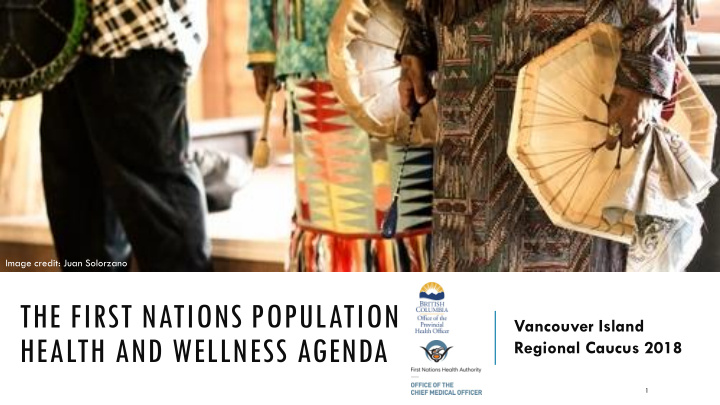



Image credit: Juan Solorzano THE FIRST NATIONS POPULATION Vancouver Island HEALTH AND WELLNESS AGENDA Regional Caucus 2018 1
PRESENTATION OVERVIEW 1. Introductions 2. The First Ten Years: Transformative Change Accord 3. The Next Ten Years: The First Nations Population Health and Wellness Agenda (PHWA) • Provincial Health Officer and FNHA Chief Medical Officer Partnership • Context, Background and Guiding Principles of the PHWA • Indicator Development Process • An Overview of the New Indicators 4. Discussion and Feedback 2
THE TEAM • Collaboration between the Office of the PHO, Office of the CMO and other FNHA/Ministry of Health departments • Executive leads: Dr. Evan Adams, Dr. Shannon McDonald and Dr. Bonnie Henry, Dr. Danièle Behn- Smith • FNHA Consultant: Dr. Perry Kendall • Project managers: Lindsay Beck, Sarah Lalonde Adrienne Bonfonti and; • Many Working Group members 3
TRANSFORMATIVE CHANGE ACCORD: INDIGENOUS HEALTH & WELL-BEING THE FIRST 10 YEARS *Prepared as per commitments in the 2005 Transformative Change Accord , through a partnership between the Office of the Provincial Health Officer, and the First Nations Health Authority 4
FIRST NATIONS POPULATION HEALTH AND WELLNESS AGENDA: THE NEXT 10 YEARS • Standing together: PHO and FNHA CMO presentation at Gathering Wisdom 2016 • A renewed set of indicators to be measured and reported on for the next 10 years • Supporting FNHA’s vision for Healthy, Self-Determining, & Vibrant BC First Nations Children, Families, & Communities 5
THE INDICATORS FRAMEWORK TRA TRANSF SFORMA MATIVE TIVE CH CHANGE A GE ACCORD FN HEA FN EALTH TH PL PLAN • Shifting the paradigm towards strength- based reporting • Paying attention to the root causes
GUIDING PRINCIPLE: TWO-EYED SEEING • Two-eyed seeing: bringing together Indigenous Knowledge & ways of knowing, alongside Western knowledges & ways of knowing. • Acknowledging the limitations of available data • Integrating knowledge and stories
DEVELOPING THE AGENDA: PARAMETERS • Valid and reliable • Available data source (with exceptions!) • Fills a gap in knowledge/attention • Provincial/regional scale (as opposed to community-based or local focus) • Action-oriented Image source: FNHA, 2017 8
POPULATION HEALTH AND WELLNESS AGENDA: NEXT STEPS • First report scheduled to be presented and released Fall 2019 • Report release every 2.5 years • Recommendations, targets and actions to be developed. 9
INDICATOR SELECTION PROCESS • Drew on feedback from Regional Wellness Indicator Development Sessions that were hosted by FNHA in 2016. • PHO and FNHA committee process to develop and narrow down the list of indicators (150 to 15) • Quantitative data sources have been identified (Regional Health Survey, Census etc.)
THE INDICATORS TRA TRANSF SFORMA MATIVE TIVE CH CHANGE A GE ACCORD FN FN HEA EALTH TH PL PLAN
LAND, NATIONS, COMMUNITY & FAMILY WELLNESS Indicator Source Work with Indigenous Knowledge An indicator that measures the holders to define and measure strength and health of our communities as collectives (i.e. self- determination) An indicator that represents the Work with Indigenous Knowledge holders to define and measure health of the relationships with the ecosystem/environment around us Discussion Question: If you could choose ONE (the ultimate) indicator to measure these areas, what would it be?
13
Recommend
More recommend